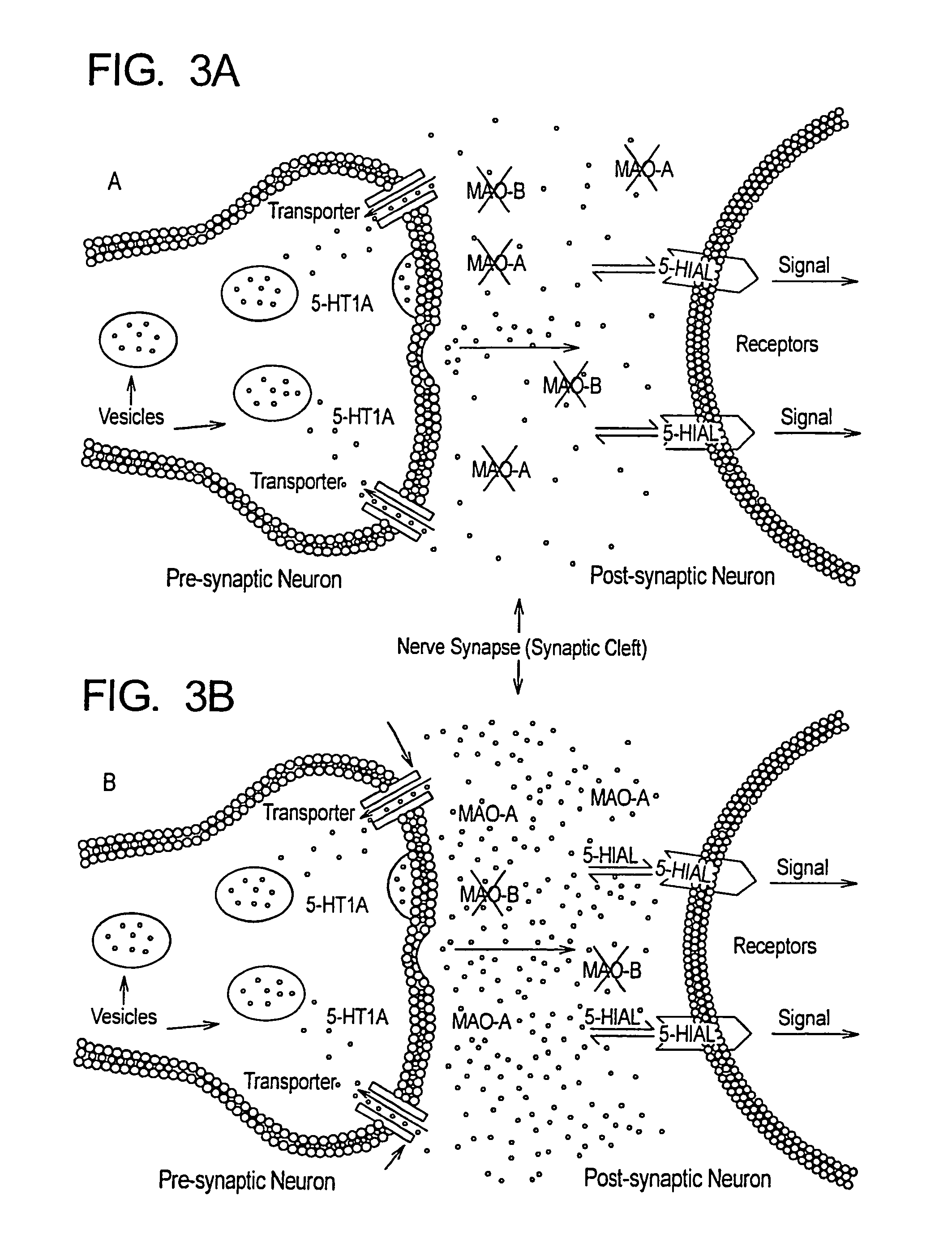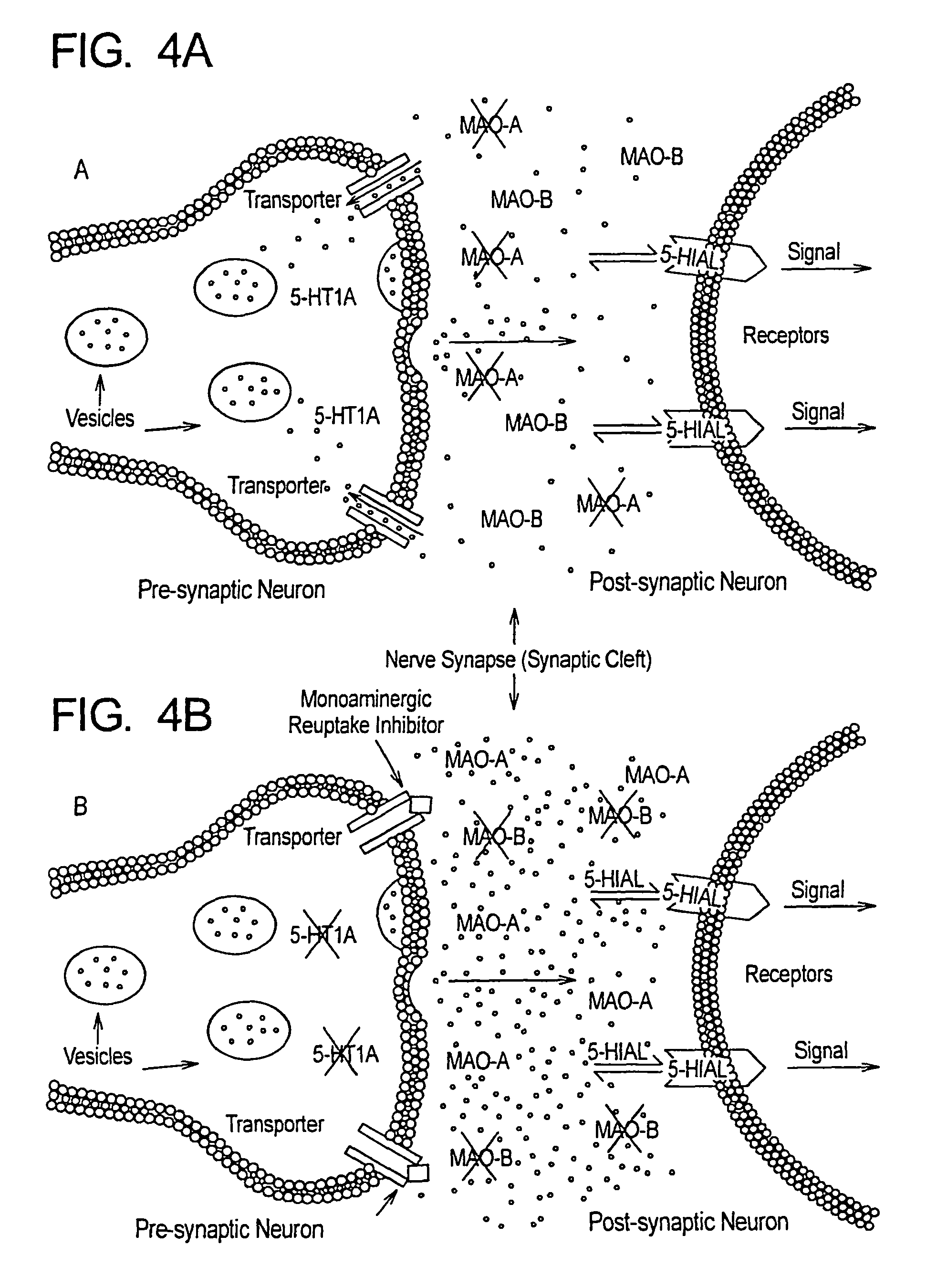Method for treatment of neurologic dysfunction
a neurologic and dysfunctional technology, applied in the field of neurologic dysfunction treatment, can solve the problems of hypertensive crisis or death, interfering with a person's daily functioning, and very limited use of today's technology,
- Summary
- Abstract
- Description
- Claims
- Application Information
AI Technical Summary
Benefits of technology
Problems solved by technology
Method used
Image
Examples
example four
[0096]A 64-year old female with a family history of depression and a personal history of major clinical depression, who had been hospitalized in 1975 and again in 1990 with major episodes of depression, including extreme suicidal ideations. Numerous different medications were tried in an effort to stabilize her condition, with only limited success. Since 1990 she had been taking 25 mg to 75 mg of nortriptyline to manage her depression, and reported having to increase the dose to as high as 100 mg during stressful life events. The patient experienced dry mouth and constipation as side effects of using nortriptyline. The patient reported suffering from the following symptoms, despite taking nortriptyline:[0097]Decreased energy, fatigue[0098]Early morning awakening
[0099]The patient discontinued the use of nortriptyline and the same day started the treatment of the present invention, using 0.01 mg of the reserpine per 0.05 ml cream, applied transdermally by rubbing the cream into the sk...
example five
[0100]A 24-year old female weighing 180 pounds with a clinical diagnosis of depression. This patient had been using a serotonin reuptake inhibitor (SSRI) for three months with moderate effect in alleviating her symptoms of depression, with the exception of labile emotions consisting of transient irritability. The patient experienced a 15-pound weight gain while using the serotonin reuptake inhibitor.
[0101]Due to the weight gain, the patient had discontinued the use of the serotonin reuptake inhibitor for a period of two months prior to starting the treatment of the present invention. She reported that during this lapse in treatment all of her symptoms of depression had returned, which included:[0102]Insomnia[0103]Fatigue throughout the day[0104]Labile emotions including irritability and spontaneous crying[0105]Feelings of hopelessness and “doom and gloom”
[0106]The patient then started the treatment of the present invention, using 0.01 mg of the MAO-A activity stimulator (reserpine) ...
example three
Improvement of Symptoms Following Administration of the Present Invention (Transdermal Reserpine) in a 12 Year-Old Male with Autism
Case Presentation
[0174]The patient is a 12-year old male who was diagnosed with Autism at 3 years of age. The patient appeared to be a normal little boy until age 2. His mother reports that she would frequently sit and read him books and he was beginning to pronounce some words, such as “truck”, “mama”, “dada”, and “duck”. He would point at things when his mother would ask him to show her where an object was which was evidence that he was comprehending language. Then one day his ability to understand and mimic speech disappeared. His mother said that she was reading him a book and he grabbed the book and tore it up and from that day forward, he refused to be read to or have any interest in books. He lost the first words he had mastered and has been nonverbal since with the exception of making the “aaaaaaaaa” sound as he bangs two plastic sticks together ...
PUM
| Property | Measurement | Unit |
|---|---|---|
| time | aaaaa | aaaaa |
| spectrum disorder | aaaaa | aaaaa |
| energy | aaaaa | aaaaa |
Abstract
Description
Claims
Application Information
 Login to View More
Login to View More - R&D
- Intellectual Property
- Life Sciences
- Materials
- Tech Scout
- Unparalleled Data Quality
- Higher Quality Content
- 60% Fewer Hallucinations
Browse by: Latest US Patents, China's latest patents, Technical Efficacy Thesaurus, Application Domain, Technology Topic, Popular Technical Reports.
© 2025 PatSnap. All rights reserved.Legal|Privacy policy|Modern Slavery Act Transparency Statement|Sitemap|About US| Contact US: help@patsnap.com



